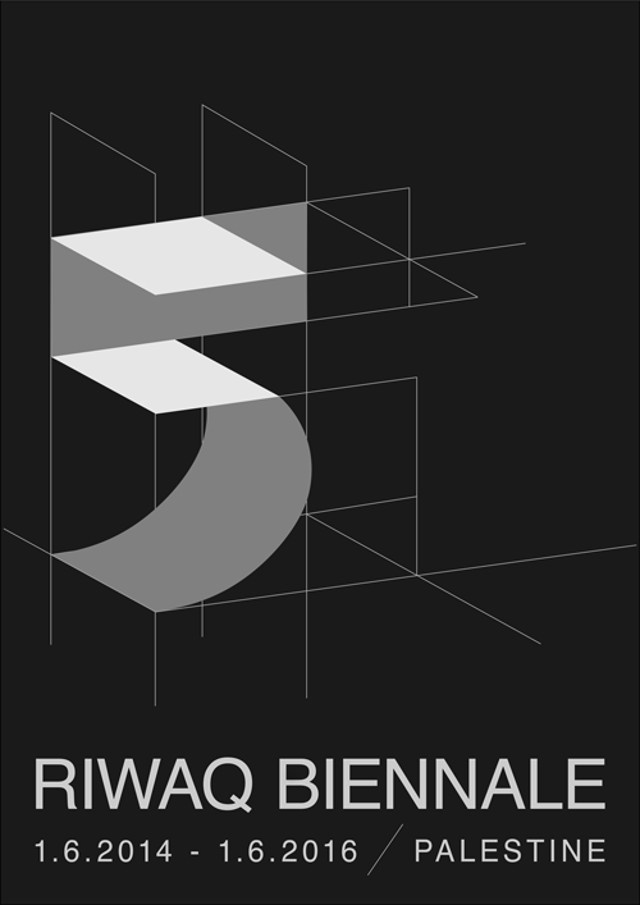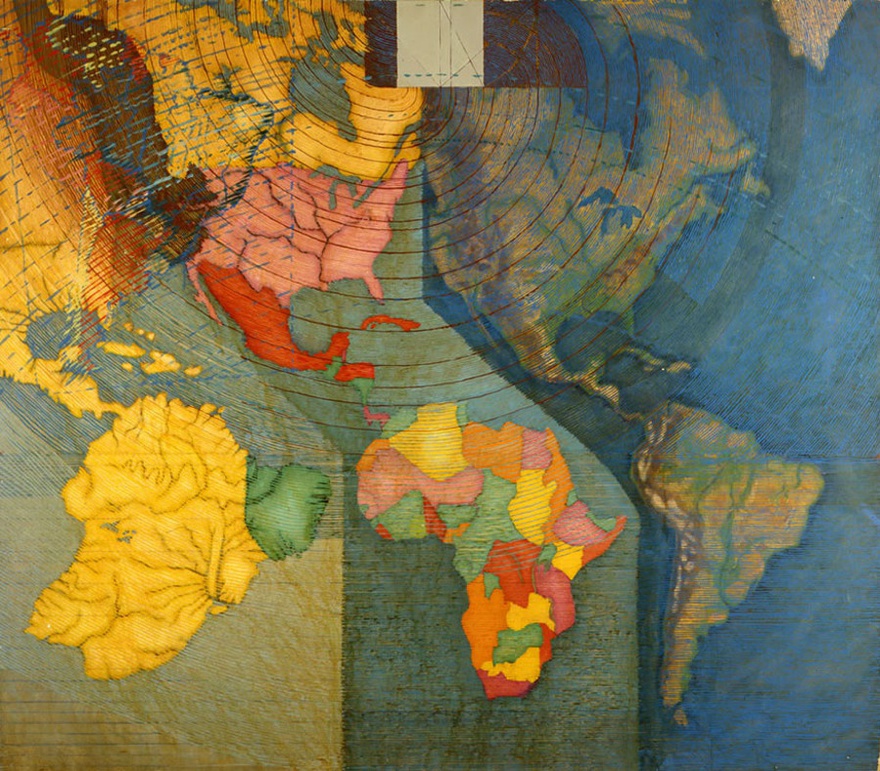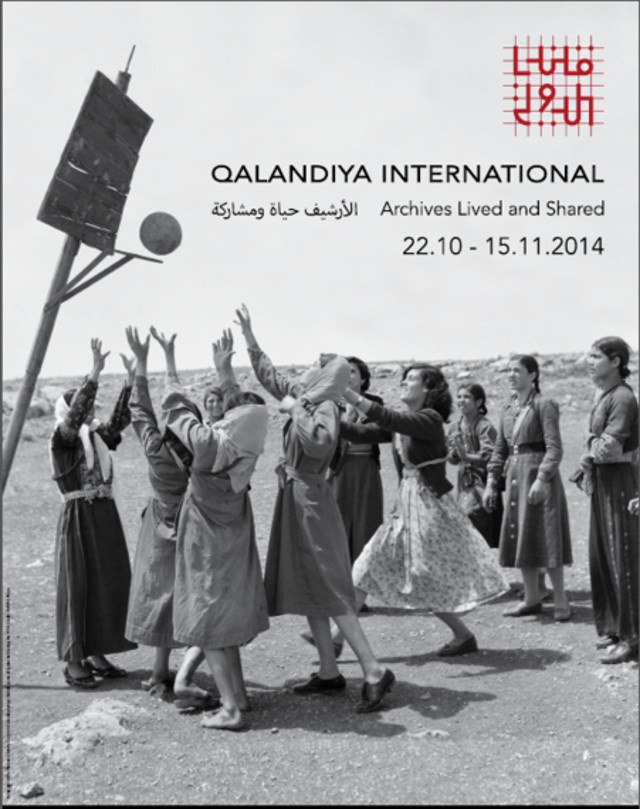Essays
Atmosphere
A Curatorial Take on the Global South
This essay will begin with a brief discussion of recent work by sociologist and cultural historian Esmail Nashif. This will allow me to then broach the topic of the 'Global South', which is at the heart of this essay, and to compare the term's all-encompassing ethos to a more strategically embodied, deliberately restricted notion of location as proposed by the 5th Riwaq Biennale in Palestine (RB5).
In 'The House', chapter two of his recent publication devoted to Palestinian abstraction and the oeuvre of Zohdi Qadry, a Russian-trained painter based in Nahf, Palestine, Esmail Nashif offers a carefully devised, very particular story of Palestinian art.[1] The point is to go against the grain of a reigning Eurocentric narrative that constructs a (very short) history of Palestinian art through the prism of the easel, as opposed to the wall: if local art history is read via the easel, the artists and practices defining the origins and trajectories of Palestinian painting are quite restricted. Nashif thus attempts to emphasize alternative sites of artistic labour, and thereby demonstrates, rather easily and elegantly, how the surfaces of various walls (whether in houses of worship, private homes, markets, cafes or government buildings) serve as more pivotal coordinates from which to map a national/local history of painterly production. To my mind, child of the nineties that I am (at least academically speaking), this is postcolonial study101. A dominant trope is identified around which a master narrative is proven to be discreetly organized, and an alternative is suggested that does not negate so much as redefine the tropes hegemonic place within the historical food chain. Concurrently, an alternative is tested for comparative legitimacy, not along similarly sweeping assumptions of universal applicability, but according to material circumstances on a specific ground.
Within the field of contemporary art, such postcolonial tactics are played down as old-fashioned, and treated with hasty admonitions to 'keep up' with some contemporary momentum that is only implicitly circumscribed, rather than clearly named. In my eyes, these moments of re-inscription, followed up by occasional, gnarly moments of strategic essentialism, remain helpful – provided, however, that one is genuinely interested in alternative histories of concrete sites of display (an interest which, in contemporary art, is not as palpable as the lip service would have you believe). What I am attempting to discern here, in other words, is which of the multiple political sensibilities around me may or may not dovetail appropriately with the budding debates around the idea of a Global South, from the traditional postcolonialism of Nashif to the intuitive internationalism of contemporary art, with its catchy references to some Narrow North as the Bad Object in the room.
Nashif's book gets rather more challenging in subsequent chapters, as he moves from paint on easels and walls to what he calls 'Palestinian abstraction'. Surely this is a double bind par excellence, given that localities – especially the ones we call 'Nations' – are always already a form of abstraction in themselves. That said, there's a notable difference between 'Palestinian abstraction' and 'abstraction in Palestine' for example. The phrasing 'abstraction in Palestine' leads straight to a dialectical headlock with the Zionist narrative. 'Palestinian abstraction', meanwhile, is the kind that can unfold in the Russian towns where Zohdi Qadry absolved his art education, or at Ben Gurion University where Nashif is member of faculty, in a political atopia like Ramallah, where the book launch took place, or even at the 'Palestinian Museum', which is materializing in nearby Birzeit, a university suburb of Ramallah, as I type. Not a 'museum of Palestine', but a museum that is Palestinian in its political and aesthetic telos; a bit like 'Palestinian knafeh', where it's the ingredients, the method, the flavour that are national, not the kitchen where it's cooked up. The above might be summarized as a classic (postcolonial) method of writing your way out of marginalization; insisting on concrete, tangible cornerstones (easel and wall) and yet circumscribing the steadfast geopolitical coordinates that avoid the one-track teleology of victim and perpetrator, serf and master.
At first glance, the Global South arguably offers a comparable game plan in that it conjures a finely crafted shade of placelessness that, in its political horizon, relies on a tactical naming of something both concrete and theoretical, both positioned and evasive. 'Palestine' begins to seem like a pendant to, constituent of, and active player within, an immaterial 'South'. The difference, in my eyes, lies in the Global South's proximity to latter-day key tenets of contemporary art. Namely, a broad identification with the marginal (in terms of art being intrinsically powerless) that in turn allows for a deep-seated identification with the indeterminate, ambivalent and open-ended as intrinsic features of contemporary art: this even when the art is polemical, pedagogical, consequential and hegemonic. The narrative of a Global South, from what I can discern at this point, suggests a sense of a shared arena that dovetails well with this shared notion of a marginality of choice. As argued elsewhere,[2] contemporary art professionals are not only familiar with this sentiment but actively and often passionately identify with it; indeterminacy as a mark of pride.
Only after this initial moment of collective 'southern' identification, does the audience, thus interpellated, move to clarify the actual terms and stakes of the debate. At which point, given its planetary scope, it necessarily branches out into kaleidoscopic specificities and anti-ontological proposals, which, in turn, will confirm what contemporary art suggested all along: that it is contemporary in that it is indefinable, and it is indefinable because it is as infinitely complex as the world it is borne of. To take a specific example, when the World Biennial Forum (WBF) posits the Global South as a 'starting point', of their recent convention, this sets a very particular tone. The organizers could have begun by saying: 'taking the habitus of Anglophone, upper-middle class cultural producers as a starting point' (or even 'taking the metropolitan cultural industries as a starting point'), which might have been refreshing, but would not have amounted to the same kind of icebreaker. To be clear, however: any discussion of new transnational networks that attempts to pinpoint the motivations behind these networks, whether through the prism of the Global South or otherwise, needs to be encouraged. My critique pertains specifically to the perspective of a contemporary art practitioner.
It seems the terminology in question will lastingly mark this mid-decade moment, along with accelerationism, New Rationalism and other recent master tropes (some more helpful than others). Such, at least, is the impression that is raised by the sheer frequency, and contagious enthusiasm with which the term comes up in conversation; even the very geographic locations of its usage point to a bewildering diversity; from the WBF, to a PhD programme in Australia, to a project space in Tehran, to the platform that is the Ibraaz journal itself, to the wide range of interdisciplinary academic platforms to be found online. A look at the resonance of the term 'South' alone, in each of these wildly differing cases, will highlight how the term productively functions as a faux ami that is not descriptive but prospective in its modus operandi. A term that is auto-legitimizing in that it allows for the very transnational dynamic it posits as its moral horizon.[3]
Within contemporary art, matters such as 'regional ontological insecurities' – insecurities both sparked and abetted by appellations such as 'Global South' – are generally analysed via the tenet that any take on power, politics and engagement needs to remain a formal one fundamentally. And in a field that is beholden to exceptionalism, systemic subversion, and the dis-identification with power above all else, a terminology that posits a discursive common ground only to invariably add up to particularity and exceptionalism – as the compendium of all the different 'Souths' invariably will – is poised to be a winner.
This is why overarching categories are routinely invoked, in contemporary art, only to be deftly undermined (categories ranging from 'culture', to 'local', to 'reality', to 'critique', to 'art' itself, and so on). The very act of disidentifying with the category and its institutional weight can offer a sense of complexity and placelessness, subversion and irony. And, to state the obvious, spatial metaphors are all the more subject to the rhetorical bait-and-switch that is at play here. Consider the number of events we must endure on 'Arab art' or the 'Middle East', all of them peppered with the jouissance of curatorial semi-apologetics and editorial proto-disclaimers and so on. Rarely is this dynamic spelled out as didactically and clearly as in Thierry de Duve's famous article discussing the display of gruesome, violent photographs within an art context (de Duve uses the example of the Khmer Rouge genocide). Branding images of massacres as an aesthetic category within a White Cube setting, say, would be frowned upon, not only for being crude, but also for being banal and uni-dimensional. Similarly, holding 'humanitarian' shows in NGOs and embassies, for example, is also lacking in the constitutive indeterminacy of contemporary art. The latter would require a blending of spatial coordinates and criteria; an exercise in re- and de-territorialization that condenses the incompatible, and exoticizes the familiar.
What are the material preconditions that allow for the circulation of a globally southern discourse in the first place? Moving away from the use of spatial metaphor, let's consider the working conditions, infrastructures and class backgrounds that are operative within the circulatory networks contained in such cartographies. Professional parameters of this kind are exceedingly – and increasingly – hard to differentiate along the lines of a north and a south. It's true that the institutional density in, say, Amsterdam still does not compare to the one in Beirut, let alone Tehran. But should you endeavour to trace the material movements, currencies, networks and discourses that criss-cross this institutional landscape, the more the east/, north/south coordinates begin to wobble?
For example, arts writers everywhere are routinely comforted for their tiny fees by means of hearty references to global circulation. An editorial benchmark – an employment premise (labour in return for the hard currency of exposure) – that speaks more clearly about global values at play than an essay's actual content possibly could. Financial vulnerability aside, the sense of being underrated and exhausted is rampant among arts writers, and will not be changing anytime soon. Most importantly, the genuinely global phenomenon that is the lack of support structures for these writers, is actually consolidating the fundamentally indeterminate, anti-polemical sense of politics described above. Admittedly, nagging about fees will seem infinitely trite to those invested in the bigger picture, but it's hard to overestimate the structural importance of the material conditions that support the ideological overlay. Indeed, they can actually redefine it if taken seriously enough.[4]
Allow me to end with a concrete exhibitionary context, as a counterexample or case study. Just as I began compiling notes for this essay, I was actually immersed within the heady atmosphere of the biannual Qalandiya International event, the largest art occurrence in Palestine to date. Everything happens at once, no one has time, and the general spirit is one of excited, cheerful breathlessness that is hard to resist. In terms of its internationalist outlook, the Qalandiya focus is very much on numbers; the masses of artists, journalists and visitors flying in and out; numbers that are widely quoted, memorized and flaunted. One would be forgiven for assuming an understandable Palestinian eagerness to expose the 'situation' to a broader audience. And yet it's striking, actually, to which point exercises in show-and-tell have been losing in political currency. There's no question that international testimony will always be important, regardless. But a discursive shift towards building sustainable structures, for those living here right now, is pretty much unmistakable. Be that as it may, the Qalandiya ethos is one of circulation and exposure, of broad strokes of sympathy and identification that ultimately invites you to disregard the precise ways in which a body can be moved through space. And the ways in which this movement dictates how much a visitor is willing to take in per minute and square metre and so on.
Qalandiya aside, international circulation is a strange thing in art. We scoff and belittle, but at the end of the day, we do play ball. Even if the discourse is stereotypical, the working conditions abysmal, the politics stereotypical at best. We content ourselves with nagging behind the scenes, promising ourselves it's the very last time we ever do this, ever ever. It seems there's little hope of improving the level of this conversation, which has been merrily chasing its tail since Les magiciens de la terre (1989). Unless, that is, the inconspicuous stories told by the wall and the easel, and other material factors, are taken into account with a little more patience. With this kind of thing in mind (and with the conceptual prompting of artist Hassan Khan), RB5 conceived of a response to Qalandiya International which did not announce so much as embody or enact its oppositional stance. Ten (remunerated) artists were invited to a discussion addressing the question of transnational networks and exposure, and the price they were willing to pay for such factors. The setting for this conversation, importantly, was the remote village of Deir Ghassaneh, from which no one could easily escape. A claustrophobic no exit setting for a discussion held in Arabic, and spanning nearly five hours. With such ghastly parameters, the audience was predictably small, but unusually devoted.[5]
The language, the number of speakers, the heated intimacy, the excessive period of time, in combination with the entrapment of the setting and exotic flair of the situation: these and other factors – including the food, prepared by Deir Ghassaneh locals – were decisive. But perhaps the most novel aspect was the fact that ten individuals were speaking as artists specifically. Once upon a time, the art field counted a far larger number of places conceived of as spaces for artists, specifically speaking. The very term vernissage points to the act of varnishing paintings just before a show. The smell alone was enough to dispel a broader audience, and varnishing days quickly became long afternoons and evenings when a professional specificity could emerge, with artists commiserating, bonding and bitching, and thereby allowing for distinctive, collective interests to emerge as such. Today, even in a biennale setup with some 120 artists, there is very rarely a moment when they dominate the stage, let alone the public conversation.
The upshot of our Deir Ghassaneh exercise is difficult to circulate, beyond settings such as this very propagandistic and somewhat paranoid essay. And yet, our artist roundtable was the kind of platform where the priorities of a South can be articulated rather thoroughly. Not by creating a broad platform of instinctive political commonalities, but by demanding an attention to concrete issues of display formats, research processes, and painful choices in terms of career strategies and personal investment. This kind of thing will crassly restrict the audience numbers, but whether the issue is art production at large, or something more violently urgent, the creation of a specifically committed audience can be just as pressing as a globally sympathetic one. Or, to put it more polemically, perhaps the creation of a globally sympathetic audience can actually preclude the production of all others.
[1] Esmail Nashif, On Palestinian Abstraction: Zohdy Qadry and the Geometrical Melody of Late Modernism (Haifa: Dar Raya Publications, 2014).
[2] Tirdad Zolghadr, 'Location, Location, Location: on the wishful marginality of contemporary art', WdW Review, March 2014, http://wdwreview.org/desks/location-location-location/.
[3]> The Global South, to my knowledge, is rarely introduced along concrete parameters that are potentially polemical or antithetical, but reassuringly caters to an appetite for shared socioprofessional legitimacy from the outset.
[4] Then again, the figure of the poor little arts writer is in itself a vivid example of that gravitational pull towards identifying with the marginal. Contemporary art – one big refugee camp of the mind. We are all exploited, exhausted, marginal – no matter how mainstream, proto-gentrifying, or intimidating we actually are.
[5] It bears mentioning that the moderator for this roundtable was Esmail Nashif himself, alongside curator Rawan Sharaf.


















